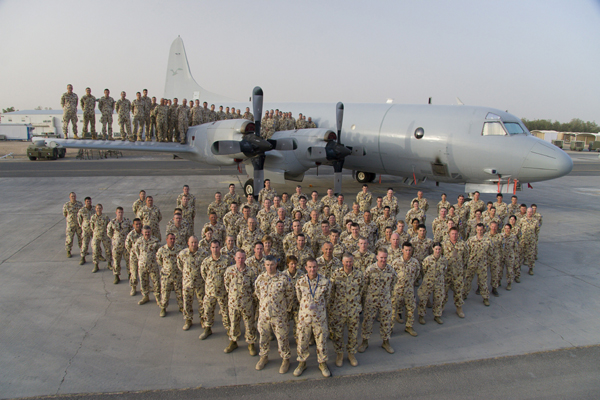Air elements
Introduction

Group photo of Task Group 633.2 members.
Source: Surveillance and Response Group, Op Catalyst Images,
Department of Defence, 3 May 2007
Government sources
Air Operations, Force Elements Currently Deployed as part of JTF633, Australian Operations in Afghanistan Fact Sheet, Department of Defence [accessed 14 August 2010]
Joint Task Force 633 Air Component Headquarters – The JTF633 Air Component provides coordination and tasking support to HQ JTF633 for all aircraft and air combat support elements assigned to Operation SLIPPER.
Intelligence Surveillance and Reconnaissance Task Unit (ISR TU) – The ISR TU includes two operational crews, who fly two AP-3C surveillance aircraft. These aircraft provide maritime surveillance of the Arabian Sea and overland surveillance of Afghanistan. ?Air Mobility Task Unit (AM TU) – The AM TU fly and maintain three C-130J aircraft which provide intra-theatre air movement for Australian and Coalition forces throughout the MEAO and Afghanistan.
Combat Support Unit (CSU) – The CSU is comprised of maintenance and support personnel who look after the administrative and support functions of the main MEAO air base, as well as Air Load Teams in Afghanistan and support personnel for the Coalition Air Operations Centre Detachment.
Heron Detachment – The Heron detachment arrived in Afghanistan in July 2009 providing additional aerial surveillance capability for Australian and Coalition troops fighting Taliban extremists and bringing stability to the country. While the Australian Defence Force has operated the Scan Eagle Unmanned Aerial Vehicle (UAV) at a tactical level for some time; the Heron UAV is a much larger aircraft and is capable of providing medium altitude reconnaissance, surveillance and mission support.
The ADF detachment has been integrated into the already established Coalition Heron UAV Detachment in Afghanistan since late July 2009. The detachment, comprising of mostly Air Force and a small number of Army personnel, is gaining valuable information and experience from the already experienced detachment.
C-17 Support – On 10 July 2009, a RAAF C-17 conducted the first mission by an Australian C-17 into Afghanistan. C-17 aircraft from the RAAF’s Amberley (Queensland) based 36 Squadron provide routine strategic lift support to Australian forces in the MEAO including Afghanistan.
Combined Air Operations Centre (CAOC) Detachment – A small element is co-located with the MEAO CAOC. This detachment provides important information and liaison duties to enable ADF air operations throughout the MEAO.
Aircraft damaged in flare incident in Middle East, Media Release MSPA 122/10, Department of Defence, 22 April 2010
A Royal Australian Air Force AP-3C Orion aircraft has been damaged during an in-flight incident over southern Afghanistan. The incident was related to the irregular release of one of the aircraft’s counter-measure flares due to a systems malfunction. The incident occurred on the afternoon of Thursday 08 April, 2010.
Air Force AP-3C Orions – 7 years of continuous Middle East operations, Media Release, Department of Defence, 29 January 2010
Chief of Air Force, Air Marshal (AIRMSHL) Mark Binskin said the Orions had flown more than 1750 missions involving 16500 flying hours supporting Operations Bastille, Falconer, Catalyst and Slipper.
During the past 7 years the Orion crews have conducted overland intelligence surveillance and reconnaissance (ISR) tasks in Afghanistan and Iraq… working closely with the US-led Combined Maritime Force (CMF) and other international task forces. The RAAF Orion detachment in the Middle East includes approximately 88 people and two aircraft.
Group photo of Task Group 633.2 members, Surveillance and Response Group, Op Catalyst Images, Department of Defence, 3 May 2007
Analysis
See also:
- Manas Air Base
- Al Minhad Air Base, Dubai
- ADF in Afghanistan – history
- Heron Unmanned Aerial Vehicle (UAV) detachment
Additional research: Arabella imhoff
Ronald Li
Updated: 18 January 2011

